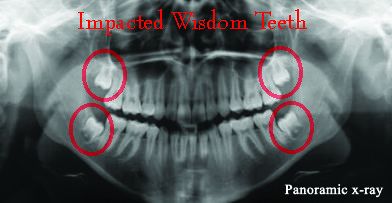3 Warning Signs of Impacted Wisdom Teeth

Wisdom teeth, the last teeth in the mouth to break through the gums and located furthest back in the mouth, usually begin to form in pre-teen years. By late teen years, the these teeth will begin to erupt into the oral cavity… if there is room.
More often than not, our mouths lack the adequate space for these teeth, leading to either full impaction (where the tooth never fully erupts into the mouth), or partial impaction (where the tooth only has room to partially break through the gums). This usually means that the teeth are painfully lodged in the jawbone.
When wisdom teeth are either partially or completely impacted, complications can arise, such as damage to adjacent teeth, gum disease, tooth disease, and cyst development. Sometimes, though, no symptoms are present.

3 Warning Signs of an Impacted Wisdom Tooth:
– Pain and tenderness in the back of the mouth
– Difficulty chewing
– Redness and/or swelling of the gums in the back of the mouth
 Treatment
Treatment
The treatment for impacted wisdom teeth is usually removal. Modern surgical and anesthesia techniques allow for comfortable and efficient removal of wisdom teeth. Recovery time is minimal – usually less than a few days – and most patients experience no more than some swelling after the surgery. We screen for impacted wisdom teeth beginning in the teenage years, as removal can be more difficult with increasing age.
